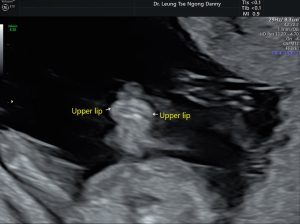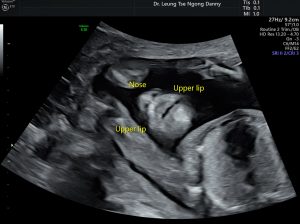- Facial cleft refers to a gap in the face. In most of the cases, there is involvement of the upper lip (cleft lip) +/- palate (cleft palate). The incidence is ~ 1 in 500 to 700 pregnancies. Other forms of facial cleft are possible, such as horizontal cleft lateral to the mouth but they are much rarer;
- For cleft lip and cleft palate, the condition can affect only the upper lip or the palate or both. It can be unilateral or bilateral and less commonly at the midline;
- Antenatal ultrasound diagnosis of cleft lip can be made as early as in the first trimester at 12-13 weeks of gestation (see photo). However, the fetal position at early gestation could make the diagnosis difficult. In any case, examination of the fetal lip should be a standard practice at the mid-trimester fetal morphology scan and it is estimated that the detection rate should be >95%. If cleft lip is found, concomitant cleft palate should be searched for as it is usually found in ~50% of cases. For isolated cleft palate, the diagnosis is difficult as the intact aveolar ridge in front would block the ultrasound imaging of the palate. Occasionally, a mild form of cleft lip occurs and appears as a small dent in upper lip or look like a scar from the lip up to the nostril. This is called ‘microform cleft lip’ and antenatal diagnosis is almost impossible;
- Cleft lip with or without cleft palate is an isolated finding in the majority of cases but this condition can be associated with chromosomal anomalies, in particular Edwards and Patau syndrome, and genetic defects. Hence, a detailed fetal morphology scan is advised;
- An amniocentesis should also be considered for fetal karyotyping and array CGH;
- For isolated cleft lip with or without cleft palate, the long-term prognosis depends on the extent of the abnormalities. A series of postnatal surgery might be needed for correction of the gaps, dental problem and cosmetic issues (see the management plan for facial cleft). The overall results are good. Over 80% should have normal speech after therapy;
- Once the diagnosis is made, referral to paediatric/ plastic surgeon with experience of the repair operations for counselling would be of help to the couple;
- The Hong Kong Association for Cleft Lip and Palate (www.cleftlip.org.hk) is a non-profit organization in Hong Kong which offers support to families with babies affected by cleft lip and/ or palate. The volunteers there also offers counselling during pregnancy.
Management plan for cleft lip and palate:
- All treatment plans for patients with facial cleft should be tailored made based on the extent of the defects and the individual needs. A team of paediatician, paediatric surgeon, speech therapist, dental surgeon and clinical psychologist should be involved for the best outcome. A typical care plan timetable for cleft lip and palate is as follows:
- (i) birth to 6 weeks – feeding assistance, support for parents, hearing tests and paediatric assessment
- (ii) 3 to 6 months – surgical repair of the cleft lip
- (iii) 6 to 12 months – surgical repair of the cleft palate
- (iv) 18 months – speech assessment
- (v) 3 years – speech assessment
- (vi) 5 years – speech assessment
- (vii) 8 to 12 years – bone graft to repair a cleft in the gum area
- (viii) 12 to 15 years – orthodontic treatment and monitoring jaw growth


